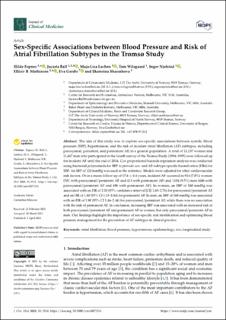| dc.contributor.author | Espnes, Hilde | |
| dc.contributor.author | Ball, Jocasta | |
| dc.contributor.author | Løchen, Maja-Lisa | |
| dc.contributor.author | Wilsgaard, Tom | |
| dc.contributor.author | Njølstad, Inger | |
| dc.contributor.author | Mathiesen, Ellisiv B | |
| dc.contributor.author | Gerdts, Eva | |
| dc.contributor.author | Sharashova, Ekaterina | |
| dc.date.accessioned | 2021-09-13T07:03:06Z | |
| dc.date.available | 2021-09-13T07:03:06Z | |
| dc.date.created | 2021-09-01T22:08:50Z | |
| dc.date.issued | 2021 | |
| dc.identifier.issn | 2077-0383 | |
| dc.identifier.uri | https://hdl.handle.net/11250/2775340 | |
| dc.description.abstract | The aim of this study was to explore sex-specific associations between systolic blood pressure (SBP), hypertension, and the risk of incident atrial fibrillation (AF) subtypes, including paroxysmal, persistent, and permanent AF, in a general population. A total of 13,137 women and 11,667 men who participated in the fourth survey of the Tromsø Study (1994–1995) were followed up for incident AF until the end of 2016. Cox proportional hazards regression analysis was conducted using fractional polynomials for SBP to provide sex- and AF-subtype-specific hazard ratios (HRs) for SBP. An SBP of 120 mmHg was used as the reference. Models were adjusted for other cardiovascular risk factors. Over a mean follow-up of 17.6 ± 6.6 years, incident AF occurred in 914 (7.0%) women (501 with paroxysmal/persistent AF and 413 with permanent AF) and 1104 (9.5%) men (606 with paroxysmal/persistent AF and 498 with permanent AF). In women, an SBP of 180 mmHg was associated with an HR of 2.10 (95% confidence interval [CI] 1.60–2.76) for paroxysmal/persistent AF and an HR of 1.80 (95% CI 1.33–2.44) for permanent AF. In men, an SBP of 180 mmHg was associated with an HR of 1.90 (95% CI 1.46–2.46) for paroxysmal/persistent AF, while there was no association with the risk of permanent AF. In conclusion, increasing SBP was associated with an increased risk of both paroxysmal/persistent AF and permanent AF in women, but only paroxysmal/persistent AF in men. Our findings highlight the importance of sex-specific risk stratification and optimizing blood pressure management for the prevention of AF subtypes in clinical practice. | en_US |
| dc.language.iso | eng | en_US |
| dc.publisher | MDPI | en_US |
| dc.rights | Navngivelse 4.0 Internasjonal | * |
| dc.rights.uri | http://creativecommons.org/licenses/by/4.0/deed.no | * |
| dc.title | Sex-Specific Associations between Blood Pressure and Risk of Atrial Fibrillation Subtypes in the Tromsø Study | en_US |
| dc.type | Journal article | en_US |
| dc.type | Peer reviewed | en_US |
| dc.description.version | publishedVersion | en_US |
| dc.rights.holder | Copyright 2021 by the authors. | en_US |
| dc.source.articlenumber | 1514 | en_US |
| cristin.ispublished | true | |
| cristin.fulltext | original | |
| cristin.qualitycode | 1 | |
| dc.identifier.doi | 10.3390/jcm10071514 | |
| dc.identifier.cristin | 1930654 | |
| dc.source.journal | Journal of Clinical Medicine | en_US |
| dc.identifier.citation | Journal of Clinical Medicine. 2021, 10 (7), 1514. | en_US |
| dc.source.volume | 10 | en_US |
| dc.source.issue | 7 | en_US |

